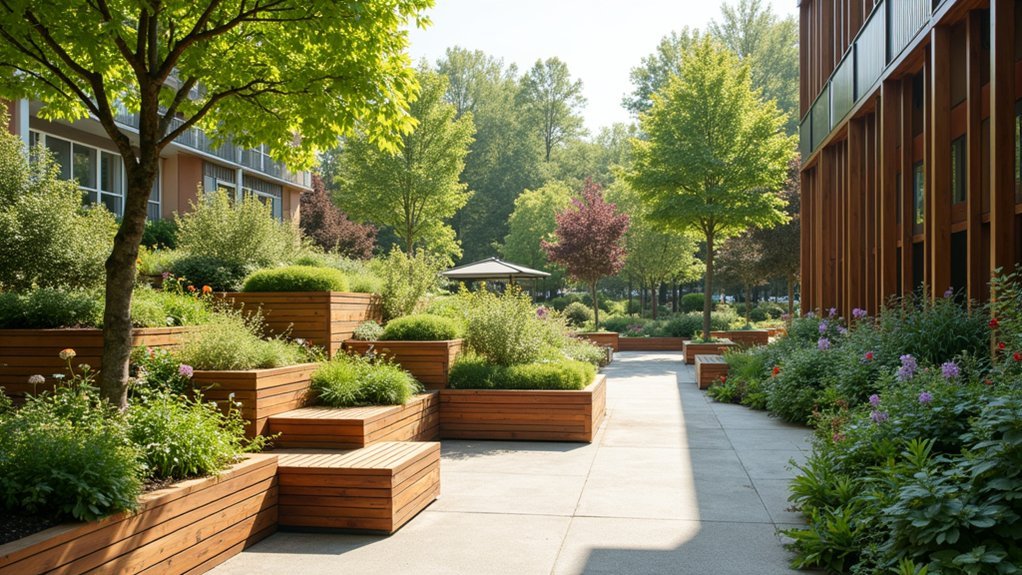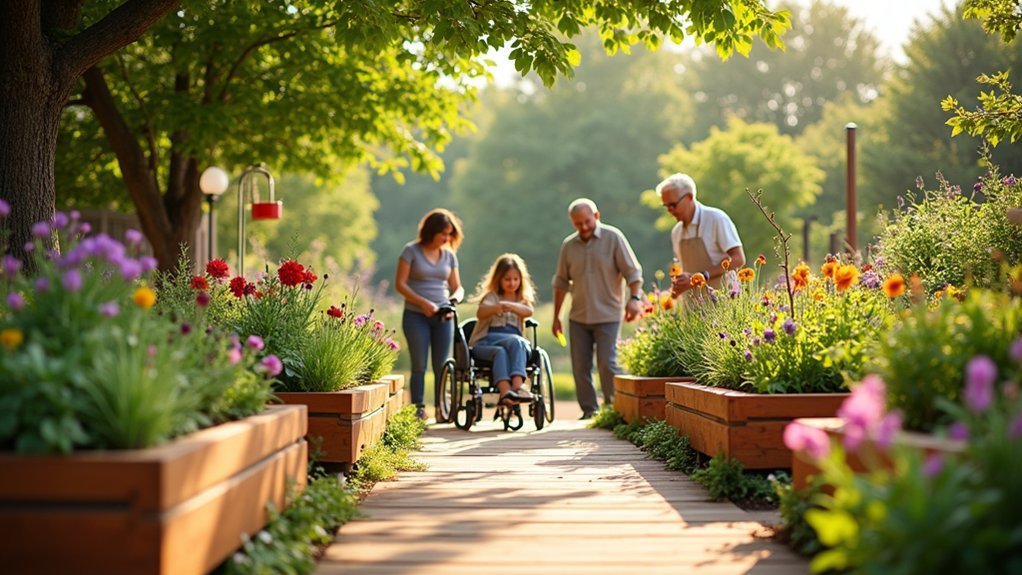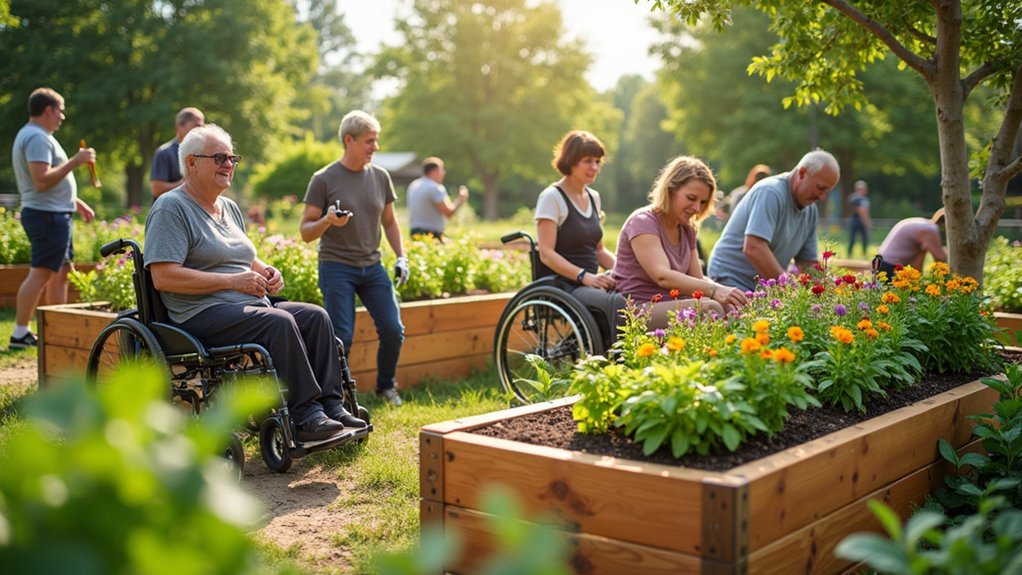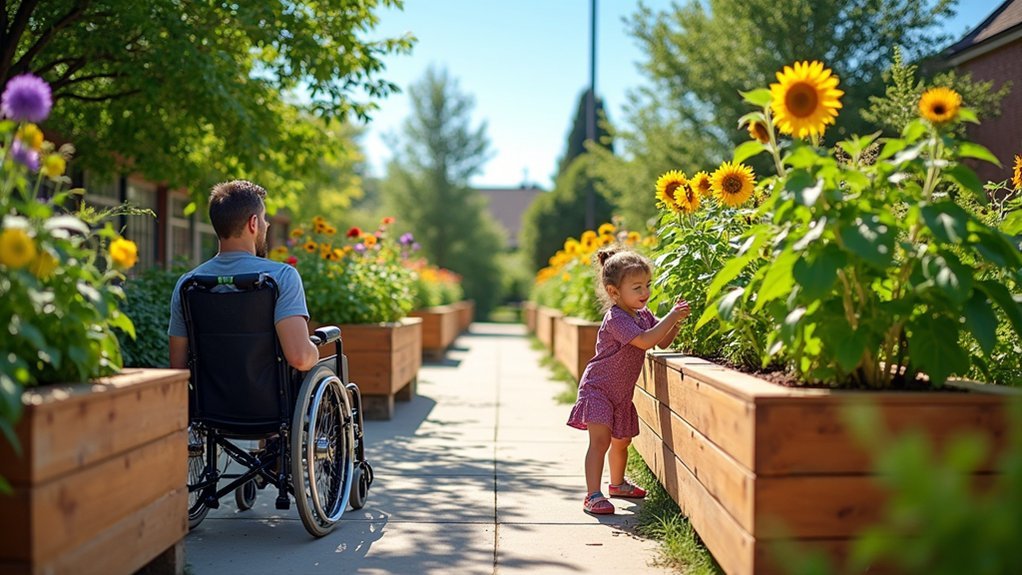Elevated garden beds make gardening accessible for people of all abilities by reducing bending and kneeling. Build beds 24-36 inches high with 3-4 foot widths, using durable materials like cedar or recycled plastic. Include pathways at least 4 feet wide with smooth, even surfaces. Add ergonomic tools with padded grips and consider tiered designs to accommodate various mobility levels. These thoughtful adaptations transform gardens into inclusive spaces where everyone can experience the physical and mental benefits of growing plants.
Key Design Principles for Accessible Elevated Gardens

While creating elevated gardens that everyone can enjoy, accessibility must be your foundation rather than an afterthought.
Start by guaranteeing pathways are at least 1.2 meters wide to accommodate wheelchairs and mobility aids. Choose smooth, even surfaces like gravel that provide stability while remaining cushioned.
Accessible garden pathways: wide, stable, and smooth—creating journeys everyone can navigate with dignity and independence.
Incorporate tiered elevated beds that serve users with varying mobility levels, and position seating strategically throughout your garden to offer rest spots. For wheelchair users, ensure the underside is recessed to allow comfortable forward access without obstacles.
Use universal imagery and signage that communicates clearly to all visitors regardless of language or ability.
Design with simple navigation patterns that don’t require explanation, and include adjustable-height planters when possible.
Remember to plan for adequate shade and guarantee your chosen materials remain durable with minimal maintenance.
Test your garden design with diverse users to verify its true accessibility.
Selecting Materials and Dimensions for Maximum Usability
Choosing the right materials and dimensions for your elevated garden transforms it from a simple planting area into a truly accessible space for everyone.
Cedar and aluminum corners provide durability, while recycled materials offer eco-friendly alternatives. Consider material thickness carefully—1-inch lumber needs support every 4 feet to prevent bowing. For the most efficient use of materials, design beds with dimensions that are multiples of 2 or 3 feet to minimize waste and cutting.
For dimensions that maximize usability:
- Build beds 3 feet wide for children and 4 feet wide for adults when accessible from both sides.
- Limit width to 2 feet for wheelchair users when beds are against walls.
- Create pathways at least 4 feet wide—preferably 5 feet—for smooth wheelchair navigation.
- Incorporate tiered planting at different heights to accommodate various mobility levels and reduce bending.
Adaptive Tools and Equipment for Diverse Gardening Needs

When building your elevated garden, you’ll need specialized tools that match your physical capabilities and comfort needs.
Consider investing in ergonomic tools with padded grips and angled handles to reduce strain on your wrists and joints during planting and maintenance.
Long-reach equipment, garden scooters, and lightweight implements can further enhance your gardening experience by minimizing bending and stretching while maximizing accessibility. Extended reach tools like pruners with heads that rotate and swivel allow you to access hard-to-reach plants without straining your body.
Ergonomic Tools Selection
Anyone who’s spent hours tending to their elevated garden knows that having the right tools can make all the difference between an enjoyable experience and a painful one.
When selecting gardening tools, prioritize ergonomic designs that keep your wrists straight and provide non-slip handles for wet conditions. Yard Butler offers several adaptive tools that feature ergonomically angled handles to ease gardening tasks.
For those with arthritis or limited mobility, look for tools with:
- Soft grip materials that reduce hand strain while maintaining a secure hold
- Angled handles that promote natural wrist alignment and minimize joint stress
- Forearm support features that distribute pressure away from your wrists
- Adjustable lengths to accommodate your specific height and reach needs
Remember that stainless steel tools offer lighter weight for easier maneuverability while providing effective leverage with minimal effort.
Modified Equipment Types
For gardeners with diverse physical abilities, adaptive tools and equipment make elevated gardening accessible and enjoyable rather than frustrating. You’ll find specialized solutions designed to accommodate various needs while reducing strain and discomfort. Bright tools with contrasting colors significantly improve visibility and usability for gardeners with visual impairments.
| Tool Category | Key Benefit | Best For |
|---|---|---|
| Long-Reach Tools | Reduces bending | Limited mobility |
| Adaptive Hand Tools | Minimizes wrist strain | Arthritis |
| Garden Scooters | Provides mobile seating | Fatigue issues |
| Wheelchair Planters | Offers knee clearance | Wheelchair users |
Consider extendable tools for reaching plants in raised beds without straining. Garden rocker seats provide essential rest periods while working. For vision impairments, tools with built-in magnifiers help identify plant details. Indoor hydroponic systems create controlled environments that can eliminate many physical barriers to traditional gardening.
Health Benefits of Therapeutic Gardening for All Abilities
The practice of therapeutic gardening offers profound health benefits that extend far beyond the simple joy of watching plants grow.
When you engage in gardening activities, you’re simultaneously improving your physical strength, mental wellbeing, and social connections in a naturally therapeutic environment. As evidenced in studies, participants who garden regularly experience significant cortisol reduction after completing stressful tasks.
- Physical wellness – You’ll build strength, improve flexibility, and enhance cardiovascular health through regular gardening movements.
- Mental restoration – You’ll experience reduced anxiety and depression while enjoying improved cognitive function.
- Social connection – You’ll develop meaningful relationships and combat isolation through community gardening programs.
- Therapeutic healing – You’ll benefit from structured horticultural therapy that can be tailored to your specific needs, regardless of ability level.
Creating Community Through Inclusive Garden Spaces

When you build garden spaces wide enough for side-by-side walking, you’ll foster natural conversation and social connection among visitors of all abilities.
Your inclusive garden can transform into a community hub when you incorporate accessible gathering areas with five-foot turnarounds and multilingual signage. These well-designed community gardens help enhance social connectedness while providing valuable health benefits to participants of diverse backgrounds and abilities.
Social Bridges Through Gardening
Diverse communities flourish within the fertile soil of inclusive garden spaces, where strangers become neighbors and isolation transforms into connection.
When you create elevated gardens accessible to all abilities, you’re not just growing plants—you’re cultivating relationships across socioeconomic, cultural, and generational lines.
These social bridges develop naturally as you:
- Welcome refugees and immigrants to share traditional growing techniques, fostering independence and cultural exchange
- Invite older adults to mentor youth, creating intergenerational knowledge transfer
- Design spaces where differently-abled participants contribute equally, dissolving perceived limitations
- Organize community harvest events that bring diverse groups together around shared accomplishment
You’ll notice how these connections extend beyond garden borders, creating lasting community bonds that address isolation and build neighborhood resilience. Through engaging in these shared garden spaces, participants experience social involvement that strengthens community engagement and fosters relationships among residents.
Accessible Gathering Spaces
How can garden spaces truly serve everyone in your community? Start by embracing universal design principles that go beyond minimum ADA standards.
Create pathways at least 36 inches wide with permeable surfaces like fine gravel or wood mulch that support wheelchairs and walkers while preventing water pooling.
Involving residents with disabilities in the planning process ensures gardens meet actual user needs, not just theoretical accessibility requirements.
Include gathering areas with varied-height seating, adequate shade, and mixed-height plantings that encourage sensory interaction regardless of physical ability.
Incorporate properly designed ramps with appropriate slopes, landings, and handrails where terrain changes occur.
These inclusive features transform gardens into community hubs where people of all abilities can connect.
Data shows accessible gardens increase health outcomes and vegetable consumption while fostering social bonds.
Though currently underrepresented in most gardens, these thoughtfully designed spaces create invaluable opportunities for diverse community engagement.
Environmental Considerations for Sustainable Accessible Gardens
As gardeners increasingly focus on sustainability, elevated gardens present unique opportunities to minimize environmental impact while maximizing accessibility. When planning your garden, prioritize recycled or reclaimed materials that offer durability while reducing resource consumption. These choices not only extend your garden’s lifespan but minimize ongoing maintenance requirements.
Sustainable elevated gardens blend eco-friendly materials with accessibility, creating resilient spaces that require less maintenance while respecting our environment.
- Implement water-efficient systems that reduce runoff and conserve resources—particularly important in drought-prone regions.
- Incorporate composting to create a closed-loop nutrient cycle, reducing external fertilizer needs while improving soil health.
- Design beds at ideal heights for both human access and soil depth requirements for healthy root development.
- Choose construction methods that allow your garden to sequester carbon through healthy soil management, contributing to climate change mitigation.
Using metal materials like those in Vego Garden beds can provide eco-friendly options that last over 20 years while reducing deforestation impacts.
Frequently Asked Questions
How Much Does an Accessible Elevated Garden Typically Cost?
You’ll find accessible elevated gardens cost $25-$50 per square foot for DIY wooden options, but professionally installed models can exceed $100 per square foot, especially with wheelchair-accessible features and durable materials.
Can Elevated Gardens Withstand Extreme Weather Conditions?
Yes, you’ll find elevated gardens withstand extreme weather well. They offer superior drainage during storms, resist waterlogging, and can be protected with row covers or windbreaks during harsh conditions. They’re naturally more resilient.
What Plants Thrive Best in Elevated Garden Environments?
In elevated gardens, you’ll find that carrots, radishes, lettuce, herbs, and flowers like zinnias and poppies thrive best. They love the well-draining soil and can be accessed easily for regular care.
How Frequently Should Elevated Garden Soil Be Replaced?
You don’t need to replace elevated garden soil annually. With proper maintenance like adding compost and rotating crops, your soil can last several years. Only replace it if it becomes too degraded to support plant growth.
Are Permits Required for Rooftop or Balcony Elevated Gardens?
Permits may be required for your rooftop garden if it adds significant weight or structural changes. Balcony gardens typically need fewer permits unless you’re modifying railings or supports. Always check your local jurisdiction’s specific requirements.
In Summary
You’ve now got the tools to create elevated gardens that everyone can enjoy. By applying accessible design, choosing appropriate materials, and incorporating adaptive equipment, you’ll create spaces where people of all abilities can experience gardening’s therapeutic benefits. Remember, inclusive gardens don’t just grow plants—they nurture communities and foster environmental stewardship. Start building today, and you’ll cultivate both beautiful gardens and meaningful connections.





Leave a Reply